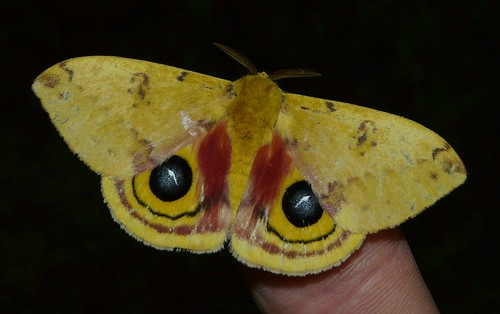 |
| Automeris io - Io Moth - At Wells Mills County Park in Waretown, NJ by Shawn Wainwright |
This is the close of National Moth Week. It was instituted to celebrates the beauty, life cycles, and habitats of moths. This year, National Moth Week is spotlighting Silk Moths around the world. Many of the silk moths are stunningly beautiful but many are also in decline. Silk moths are distantly related to the moth that is used in silk production. The adults also have greatly reduced mouthparts and do not feed. They simply find a mate and die.
This article from The NY Times has a title that says a lot about the moth - An Exaltation of Moths, Much-Maligned Kin of the Butterfly.
Lepidoptera is a large order of insects that includes moths and butterflies. Taxonomically, moths are not easily differentiated from butterflies.
Many attempts have been made to subdivide the Lepidoptera into groups but these names have failed to persist.
There are four butterflies on NJ's endangered species list: Mitchell's Satyr, Neonympha m. mitchellii, Silver-bordered ritillary Bolaria selene myrina, Arogos Skipper Atrytone arogos arogos and the Checkered white Pontia protodice
Scientists estimate there are 150,000 to more than 500,000 moth species. Their colors and patterns are either dazzling or so cryptic that they define camouflage. Shapes and sizes span the gamut from as small as a pinhead to as large as an adult’s hand. Most moths are nocturnal, but some fly like butterflies during the day.
 |
Nocturnal insectivores often feed on moths; these include some bats, some species of owls and other species of birds. Moths also are eaten by some lizards, and by cats, dogs, rodents, and some bears.
As beautiful as moths can be, many of them are pests. In New Jersey, the Gypsy Moth is a serious pest that feeds on hundreds of varieties of trees and shrubs. The moth prefers the oak as a host tree - such as New Jersey’s state tree, Northern red oak.
The Gypsy Moth, originally from Europe, was introduced to Massachusetts in 1869 by a French botanist trying to develop the silkworm industry. Once the insects escaped from his laboratory, they colonized and spread. Currently gypsy moths populate 19 states. Without intervention this pest spreads at a rate of about 13 miles per year.
 |
| Adult male gypsy moth Lymantria dispar dispar |
2 comments:
Are Crecopia mothsendangered? I just had one emerge from a large cocoon. From Mullica Hill NJ
No, at least not in NJ
see https://www.nwf.org/Educational-Resources/Wildlife-Guide/Invertebrates/Cecropia-Moth
Post a Comment